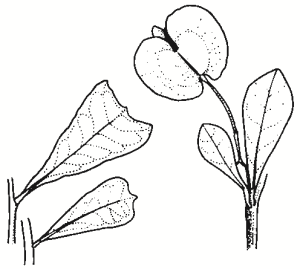Family:
Sapindaceae
Dodonaea viscosa subsp. cuneata
Wedge-leaf Hop-bush
Other Names:

Name Origin:
Dodonaea — after Flemish botanist Rembert Dodoens (1517-1585).
viscosa — sticky.
cuneata — from Latin cuneus, referring to leaf shape.
Regional Subspecies:
see also Dodonaea viscosa subsp. cuneata
Occurrence:
Regional:
In many areas across the region.
Australia:
Qld, NSW, Vic, SA.
Habitat:
Mallee scrub in semi-arid areas and open forest. Mostly on sandy loams.
Habit:
Compact spreading shrub to 3 m high with wedge-shaped green leaves.
Site Preference:
Well-drained soil.
Characteristics:
Occurs in clumps or as scattered plants in higher rainfall areas.
Flowering:
Greenish, winter-spring.
Seed Collection:
Mid-Oct to early Feb. Monitor closely as seeds released immediately or 3-14 days after maturity. Papery capsules turn from red to tan-brown and brittle as seeds ripen. Seeds black and firm when ripe. Large quantities easily collected. Retains viability for several years.
Propagation:
From seed (± 212 seeds per gram), or cuttings. While untreated seeds germinate, hot water treatment hastens germination, which should take 2-4 weeks.
Regeneration:
From seed, stem and coppice, particularly after fire. Establishes readily when direct seeded.
VALUES:
Shade & Shelter:
Useful low-level cover in windbreaks, due to multi-stemmed growth.
Land Protection:
Useful understorey in recharge planting. Useful in land rehabilitation such as stabilising sand.
Wildlife:
Excellent habitat. Good pollen source for moths, butterflies and other insects including colourful beetles. Foliage good refuge for small birds. Fruits and seeds are forage for native birds. Kangaroos and wallabies browse foliage.
First Nations:
Dodonaea leaves used for pain relief. Leaves chewed for toothache (without swallowing the juice). Chewed leaves and juice used in treating stonefish and stingray wounds (usually bound to wound and left for several days).
Ornamental:
Ornamental. Useful in hedges, screening, rock gardens and under trees. Three-angled fruits very colourful and attractive. Prune lightly to promote bushiness.
Other:
Useful drought fodder in some arid areas, but protection from livestock necessary to preserve plants. Fruiting branches have cut flower potential.
